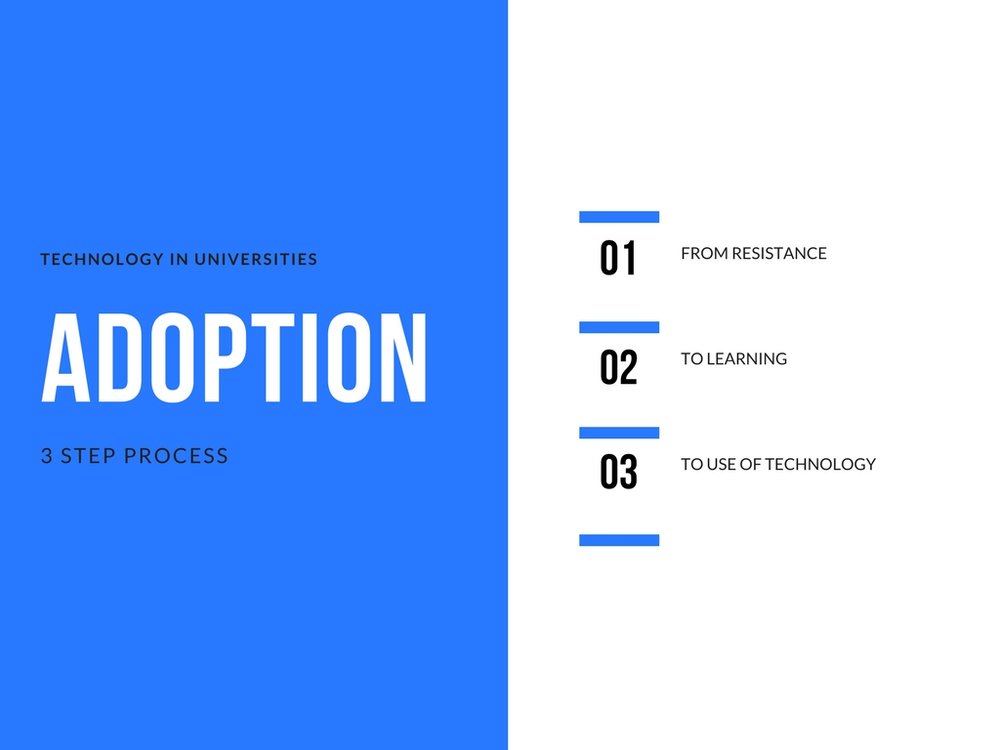Technology upgrades are becoming critical to universities that want to survive the digital age. New systems are replacing antiquated software that was introduced years ago when they were bricks and mortar, and the concept of a ‘digital campus’ didn’t exist.
Decision makers are in a delicate position as they face pressure to innovate while knowing that staff and faculty are likely to push back against change.
Staff and faculty value the stability of their existing routine, so the reticence to adopt new systems is understandable.
The resistance of faculty to changes in utilizing technology and managing that resistance may be among the most pressing challenges for leaders in academia (Berge & Muilenburg, 2001; Moerschell, 2009).
To overcome the objection to new technologies and ensure a smooth transition, start with these key strategies.
Choose platforms that are easier to learn
Whenever evaluating a new platform, one of the primary factors should be the ease at which students and staff can learn how to use it effectively.
A lot of technology companies try to reinvent the wheel when developing their user experience which is a very insular approach that causes more problems than it solves.
Designing new systems should be done in a way that makes user onboarding easy. By replicating the look and feel of existing systems and making incremental improvements, software providers are putting their users first.
A primary example is Yammer, a business communication tool, which adopted a very similar look to Facebook. The result? Extensive user adoption in the early years after release.
Explain the reasoning
To build interest in technology before it is released, it is important to provide staff with precise reasons for the decision. Be open about why the new platform is essential. Make sure that the logic is linked directly to relevant and personal outcomes.
For example
“We’re introducing this technology to build student community,”
Should be replaced with:
“We’re introducing this technology because our students continue to report that they feel unsupported and the ongoing dropout rate is unsustainable. We’re making this change to avoid potential job cuts in future.”
It is also valuable for staff to see examples of other colleges that have successfully implemented the technology. Use a case study to show how another university has changed for the better.
Showing how issues will be solved will also help convince staff that the initial pain is worth it for the long-term gain.

Find a champion
Your internal champion is your quarterback. They coordinate, control and take responsibility for delivering a successful rollout. They can’t do it all on their own, but they’re calling the shots and making sure everyone else plays their role.
The internal champion should be a respected leader within the university with a track record for getting things done. They should be afforded autonomy to make decisions about implementation as they arise. Internal back and forth is certain to hurt adoption.
Having an internal champion keeping everyone moving in the same direction increases the likelihood of a successful rollout.
Planning is paramount
There are inevitably a large number of moving parts in technology implementation, and it is imperative that they all align.
For example, setting up staff training and then realizing the IT department hasn’t completed system integrations creates a poor first impression for staff. Users disillusioned by a disappointing first experience with new technology can be some of the most difficult to recapture.

It’s necessary to have a clear plan so that everyone knows what needs to happen and when. The timeline should give staff adequate notice, so people don’t feel rushed, but shouldn’t be so long that you lose momentum and excitement. And as the saying goes, any deadline is better than not having one.
Another essential part of the planning process is determining use cases for the system and informing staff how their current workflows will change.
Establishing when and how staff will use the new system drives usage and prevents faculty returning to their ‘old ways.’
Train for success
The trainer plays a critical role in generating staff buy-in. Highly engaging training events are a must. Staff will resent a technology that they don’t understand – fear of the unknown can be powerful.
It’s also crucial to align training with the workplace culture. If staff have a preference for recorded online demonstrations that can be more convenient, run training events in this format. If they prefer constant interaction with the trainer, a seminar event is more suitable.
Throughout the training process, provide incentives to staff to show that their efforts to learn the new technology are valued. If staff feel that learning the system doesn’t lead to any reward or outcome, they can quickly undervalue the tool.
Those encouraging the implementation, including the internal champion, must become experts in the technology. Learn the frequently asked questions, so staff receive an answer quickly. Having internal experts builds confidence in the system and reduces the need for back and forth with the vendor, which takes time.
Implement a two-way feedback loop
Once the new technology has been rolled out, provide staff with both positive and negative feedback regarding their technology use to give them a chance for further learning and improvement. This process can also help them build on what they learnt during the training sessions, and often leads to ‘super users’ who develop a deeper understanding of how to get the most out of technology. It may also inform the structure and content of additional training sessions.
In addition to providing staff with feedback, it’s important to ask them what they think of the new technology. What’s working? What’s not working? Analyse all the information provided (which will sometimes conflict) for patterns and then present any trends back to the vendor. The value of this process is not just improving the technology – it helps staff to feel involved and increases buy-in.
Celebrate the successes
It’s important to share the positive impact that new technology is having within the university. Positivity is contagious, and when a staff member hears that other people have breakthroughs with a new platform, it encourages them to overcome the initial pain of change.
The added benefit is that staff will start to share the methods they used to build momentum, feeding into further success.
Summary
Universities are in a situation where they must upgrade existing technology or face being left behind.
It’s important to understand that throughout this process, staff will resist change. Accepting this is critical so you can put effective strategies in place.
Following these steps will put your university in a much better position to continue innovating, which will ultimately lead to a better experience for both students and staff.
